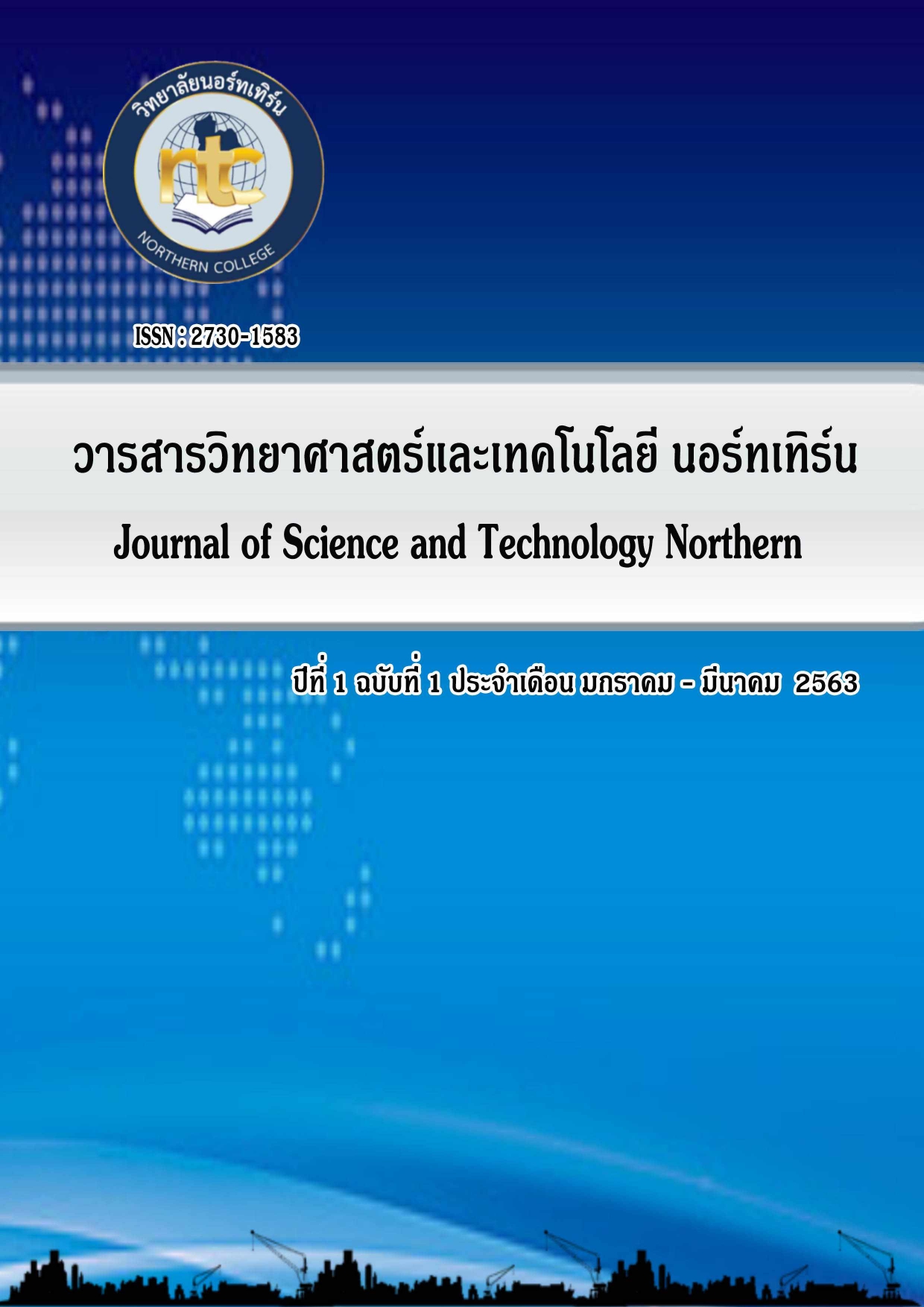Hazard Identification Techniques for Industry Case Study of Industry in Nakhon Ratchasima Province
Keywords:
hazard identification technique, Accident, IndustrialsAbstract
This research aims to review and analyze the suitability of hazard id entification techniques for the manufacturing industry in Nakhon Ratchas ima province. The results showed that all 40 hazard identification techniq ues could be suitable for industrial plants in Nakhon Ratchasima province in 13 business groups. The first three groups had the highest number of fac tories. Agro-industry and animal feed is suitable 14 Techniques, Non-metal lic industries are suitable 20 Techniques, and Transportation is suitable 14 Techniques. In addition, there are 7 hazard identification techniques suita ble for all industries in Nakhon Ratchasima province: FTA, Checklist, What -if analysis, ETA, JSA, and Safety audit, Standards / Codes of practice / Liter ature review. Identifying hazards to the manufacturing process and the na ture of the business will reduce the risk of an accident more effectively.
References
สำนักงานอุตสาหกรรมจังหวัดนครราชสีมา. (2 มีนาคม2561). รายงานความเคลื่อนไหวการลงทุนด้านอุตสาหกรรม. สำนักงานอุตสาหกรรมจังหวัดนครราชสีมา. http://www.industry.go.th/nakhonratchasima/index.php
Alison Couley. (2017). Concept Safety Review. North Yorkshire : Eggborough Power Station site.
Appil Ora. (2017). Hazard Identification of Chemical Mixing Plant through Hazop Study. International Journal of Advance Research and Development. 2(3), 79-84.
Bernhard. (2011). Identifying Software Hazards with a Modified CHAZOP.The First International Conference on Performance, Safety and Robustness in Complex Systems and Applications. 7-12.
Commonwealth of Australia (4 March 2018). HUMAN RELIABILITY ANALYSIS. https://www.nopsema.gov.au/resources/human-factors/human-reliability-analysis/
Ehsan Saghatforoush. (2014). EXTENSION OF CONSTRUCTABILITY TO INCLUDE OPERATION AND MAINTENANCE FOR INFRASTRUCTURE PROJECTS. Thesis for the degree of Doctor of Philosophy. Science and Engineering Faculty Queensland University of Technology.
Elda Paja. (2015). The importance of teaching goal-oriented analysis techniques: an experience report. 1 st International iStar Teaching Workshop. 2015(1), 37-42.
Gretchen A. (14 February 2018).). Analysis of Safety Decision-Making Data Using Event Tree Analysis. http://lib.dr.iastate.edu/abe_eng_conf /356.
Gurujeet. (24 February 2018). Hazard and operability study (HAZOP). https://www.linkedin.com/pulse/hazard-operability-study-hazop-gurujeet-mohapatra.
Howard Lee. (2017). Failure mode and effects analysis drastically reduced potential risks in clinical trial conduct. Drug Design, Development and Therapy. 2017(11), 3035- 3043.
IYAN EKA MULIA. (2016). TSUNAMI SOURCE ESTIMATION AND WAVEFORM FORECAST USING COMPUTATIONAL INTELLIGENCE. Thesis for the degree of Doctor of Engineering. The Faculty of the Graduate School of Science and Engineering Kagoshima University.
John R. Taylor. (2013). Incorporating Human Error Analysis into Process Plant Safety Analysis. CHEMICAL ENGINEERING TRANSACTIONS. 2013(31), 301-306.
Jose Condor. (2011). A Comparative Analysis of Risk Assessment Methodologies for the Geologic Storage of Carbon Dioxide. 2011(4), 4036–4043.
Kouroush. (2015). Cause-Consequence Analysis for NASA’s Space Transportation System (STS)-Solid Rocket Booster (SRB). International Journal of Business and Management. 10(8), 23-28.
Miguel A. Trigos. (2016). Unmanned Helicopter Faults Diagnosis based on Petri Nets. I+D Revista de Investigaciones. 8(2), 91–103.
Muchamad. (2017). Hazard Identification and Risk Assessment of Health and Safety Approach JSA (Job Safety Analysis) in Plantation Company. IOP Conf. Series : Materials Science and Engineering. 2017(215), 1-10.
National Offshore Petroleum Safety and Environmental Management Authority. (4 February 2018). Critical task analysis. https://www. nopsema.gov.au/assets/ Informationpapers/A500978.pdf
Patrick J. Redmond. (2007). A SYSTEM OF SYSTEMS INTERFACE HAZARD ANALYSIS TECHNIQUE. Master’s Thesis, SCIENCE IN SOFTWARE ENGINEERING and SCIENCE IN SYSTEMS ENGINEERING NAVAL POSTGRADUATE SCHOOL.
Phayong. (2017). Job safety analysis and hazard identification for work accident prevention in para rubber wood sawmills in southern Thailand. Journal of Occupational Health. 2017(59), 542-551.
Philip McAleenan. (2015). CALCULATION OF THE NUMBER OF SYNERGISTIC HAZARDS AND RISKS ON CONSTRUCTION SITES THAT LIMITS THE EFFICACY OF RISK ASSESSMENT MATRICES. Proceedings of CIB W099 Benefitting Workers and Society through Inherently
Safe(r) Construction Belfast, Northern Ireland, 10-11 September. 390-397.
SAS Institute Inc. (2015). Reliability and Survival Methods. Cary, NC : SAS Institute Inc.
Seyedeh. (2016). FRAGILITY ASSESSMENT AND RELIABILITY ANALYSIS OF TRANSMISSION LINES SUBJECTED TO CLIMATIC HAZARDS. Thesis for the degree of Doctor of Philosophy, Department of Civil Engineering and Applied Mechanics McGill University.
Stuart Burge. (2010). The Systems Engineering Tool Box. Warwickshire : Burge Hughes Walsh.
T. G. Jun. (2010). THINKING WITH SIMPLE DIAGRAMS IN HEALTHCARE SYSTEMS DESIGN. INTERNATIONAL DESIGN CONFERENCE - DESIGN 2010 Dubrovnik - Croatia, May 17-20, 1787-1794.
Vinay Dubey. (2016). Hazard Identification of cranes and their control measures. International Journal of Engineering Development and Research. 4(1), 504-509.
Yan Du. (2015). The role of hazard vulnerability assessments in disaster preparedness and prevention in China. Military Medical Research. 2015(2), 27.
Yi-nan Hu. (2016). Research on the Application of Fault Tree Analysis for Building Fire Safety of Hotels. Procedia Engineering 135 (2016), 524–530.
Downloads
Published
How to Cite
Issue
Section
License
Copyright (c) 2020 Journal of Science and Technology Northern

This work is licensed under a Creative Commons Attribution-NonCommercial-NoDerivatives 4.0 International License.







